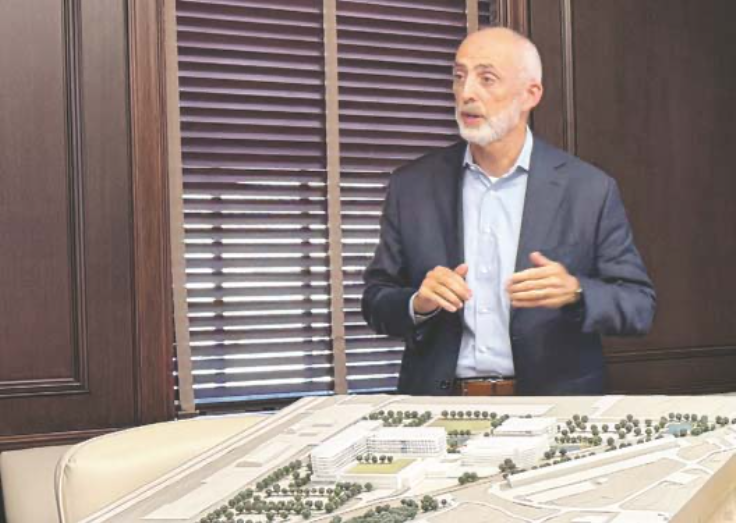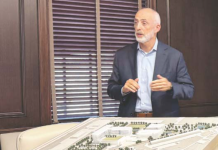
By Sunayana Prabhu
LONG BRANCH – Monmouth Medical Center plans to relocate its core services to a new acute care facility at the Vogel Medical Campus in Tinton Falls after the state advanced its expansion and license transfer application, paving the way for the hospital to shift services from Long Branch.
The move sparked sharp criticism from U.S. Rep. Frank Pallone (D-6), who denounced the plan as “corporate greed” that would harm Long Branch’s underserved community. He is urging residents to voice their opposition at a public hearing Oct. 29.
Hospital officials, meanwhile, said during an Oct. 17 press conference that a smaller footprint with services deemed essential to the area will remain in Long Branch, disputing Pallone’s claims of a full closure.
RWJBarnabas Health, which owns the 13-acre Monmouth Medical Center in Long Branch, plans to modernize and expand its health care services in Monmouth County. In 2022, the health system purchased 36 acres in Tinton Falls on the former Fort Monmouth, including the Myer research facility, which became the Vogel Medical Campus, to support the hospital’s future growth. Con- struction is underway on the first phase, a five-story Specialty and Cancer Care Center expected to be completed in 2026. The second phase calls for a new 252-bed acute care hospital to extend the cancer center.
At the press conference, hospital officials announced plans to relocate Monmouth Medical Center’s surgical, labor and delivery, and inpatient care services to the new acute care hospital, about 5 miles away.
Hospital officials said they were notified by the New Jersey Department of Health that the system’s certificate of need application is now complete, allowing plans for the proposed acute care hospital to move to the next phase of the state’s review and approval process. The designation means all required documents and information have been submitted and accepted for review, though final approval has not yet been granted. Following a public comment period that includes multiple hearings – the first scheduled for Oct. 29 – the state may issue its final decision.
What Stays, What Leaves Long Branch Campus
According to a presentation by Eric Carney, president and chief executive officer of Monmouth Medical Center, a full-service emergency room, a 24-bed observation unit, behavioral health services, and outpatient clinics will remain at Monmouth Medical Center in Long Branch. “The Long Branch community does have a higher utilization of emergency room than maybe some other communities, so we’re intentional about leaving our emergency room here,” Carney said.
The hospital, spread over 13 acres, has been operating for decades and is licensed for 510 beds. The new plans will redesign the footprint to house a state-of-the-art inpatient behavioral health center and critical mental health services for the community.
Additionally, hospital administrators assured the public that the facility will maintain its commitment to local employment, with 200 current employees living in Long Branch. Service roles in housekeeping, dietary, transport and security will continue at the existing location.
A free transportation service will connect the two campuses in Long Branch and Tinton Falls, ensuring continued patient access.
The new Tinton Falls campus will feature 100% private patient rooms. Located near major highways, the acute care center at Vogel Medical Campus will be built in two towers, a maternity tower and a medical-surgical tower. The hospital would also have a full-service emergency room, a full-service operating room suite equipped with diagnostic platforms and feature an outpatient building for physician offices.
Hospital leadership stressed that the relocation represents an expansion of services, not a reduction, with a continued focus on serving the most vulnerable populations through Medicaid and charity care programs. “We were very focused on making sure we’re meeting the needs of the Long Branch community, particularly patients that may be covered under the Medicaid program, because we know how challenging it could be for those individuals to access health care,” Carney said.
Pending New Jersey Department of Health approval, the project is expected to break ground after regulatory hearings, with first patient services anticipated in 2032.
Factors in the Decision
Carney explained that the decision to move core services was made partly to modernize the 135-year-old structure and partly through a complex analysis of patient needs and demographics.
Monmouth Medical Center sees approximately 7,000 patients a year in inpatient units covered by Medicaid, Carney noted. Of those 7,000 patients, “92%… come from outside of Long Branch,” he said, mostly from Ocean and Middlesex counties. Transferring core services like the maternity and surgical programs to the Tinton Falls location, which is accessible to major roadways such as the Garden State Parkway, Route 18 and 36, “is absolutely the right thing to do by the people we serve.”
Additionally, Carney said a 2016 architectural assessment revealed that Monmouth Medical Center’s 135-year-old structure could not sustain hospital operations for more than a decade. The evaluation exposed critical infrastructure limitations that would require over a decade of reconstruction and would cost the same as building a new campus on a new plot of land to modernize the facility. “So, the decision was clear that looking for a parcel of land other than our current footprint was the right step for us.”
Opposition to the Plan
“This is effectively a closure of the hospital, an abandonment of the underserved minority community to move to an area with wealthier patients who could pay through private insurance,” Pallone said during a press conference Friday – hours before the hospital’s announcement.
According to Pallone, the proposed plan by RWJBarnabas Health would reduce the Long Branch location to an ambulatory care center with limited emergency services, transferring full hospital services to a new Tinton Falls facility. “About a year ago, RWJBarnabas Health submitted a plan to build a new hospital in Tinton Falls. I didn’t have a problem with that, but they guaranteed me that while trans- ferring some services, the Long Branch hospital would continue to function as an acute care hospital,” Pallone said. According to Pallone, the original plan committed to keeping acute care beds, an ICU and major surgery capabilities at the Long Branch facility. “That is what is now not the case,” he said.
Pallone said the Department of Health, with Gov. Phil
Murphy’s approval, “decided yesterday (Oct. 16) that they would transfer the hospital license, which would mean no more acute care at Long Branch. In fact, it would cease to be a hospital and wouldn’t even have a license anymore.”
Pallone warned the move could trigger a domino effect, potentially threatening other regional hospitals by drawing patients with private insurance away from existing facilities. He urged community members to attend an upcoming public hearing, which is scheduled for 4 to 6 p.m. Wednesday, Oct. 29, at the Ocean Place Resort, 1 Ocean Blvd., Long Branch, and challenge the decision.
Meanwhile, regional health care providers are also skeptical of the project and bracing for the impact if the proposal is approved.
“Consequences will be felt immediately at Hackensack Meridian Health’s Jersey Shore University Medical Center and Riverview Medical Center,” Hackensack Meridian Health (HMH) conveyed in a separate press statement. Moving core services from Monmouth Medical Center out of Long Branch “is a mistake that will endanger patients and destabilize regional healthcare,” HMH said in the Oct. 17 statement.
“Replacing a full-service acute care hospital with a satellite clinic is a drastic reduction of care. It will disproportionately harm Long Branch’s uninsured, minority, and chronically ill populations who will lose their birthing center, life-saving cardiac care, and rapid access to stroke treatment. As Long Branch grows, it needs more healthcare access, not less.”
The article originally appeared in the October 23 – October 29, 2025 print edition of The Two River Times.















